- Home
- About
- Map
- Trips
- Bringing Boat West
- Migration West
- Solo Motorcycle Ride
- Final Family XC Trip
- Colorado Rockies
- Graduates' XC Trip
- Yosemite & Nevada
- Colorado & Utah
- Best of Utah
- Southern Loop
- Pacific Northwest
- Northern Loop
- Los Angeles to NYC
- East Coast Trips
- Martha's Vineyard
- 1 Week in Quebec
- Southeast Coast
- NH Backpacking
- Martha's Vineyard
- Canadian Maritimes
- Ocracoke Island
- Edisto Island
- First Landing '02
- Hunting Island '02
- Stowe in Winter
- Hunting Island '01
- Lake Placid
- Chesapeake
- Provincetown
- Hunting Island '00
- Acadia in Winter
- Boston Suburbs
- Niagara Falls
- First Landing '99
- Cape Hatteras
- West Coast Trips
- Burning Man
- Utah Off-Roading
- Maui
- Mojave 4WD Course
- Colorado River Rafting
- Bishop & Death Valley
- Kauai
- Yosemite Fall
- Utah Off-Road
- Lost Coast
- Yosemite Valley
- Arizona and New Mexico
- Pescadero & Capitola
- Bishop & Death Valley
- San Diego, Anza Borrego, Joshua Tree
- Carmel
- Death Valley in Fall
- Yosemite in the Fall
- Pacific Northwest
- Utah Off-Roading
- Southern CA Deserts
- Yosemite & Covid
- Lake Powell Covid
- Eastern Sierra & Covid
- Bishop & Death Valley
- Central & SE Oregon
- Mojave Road
- Eastern Sierra
- Trinity Alps
- Tuolumne Meadows
- Lake Powell Boating
- Eastern Sierra
- Yosemite Winter
- Hawaii
- 4WD Eastern Sierra
- 4WD Death Valley +
- Southern CA Deserts
- Christmas in Tahoe
- Yosemite & Pinnacles
- Totality
- Yosemite & Sierra
- Yosemite Christmas
- Yosemite, San Diego
- Yosemite & North CA
- Seattle to Sierra
- Southwest Deserts
- Yosemite & Sierra
- Pacific Northwest
- Yosemite & South CA
- Pacific Northwest
- Northern California
- Southern Alaska
- Vancouver Island
- International Trips
- Index
- Tips
- Books
- Photos/Videos
- Search
- Contact
Carpinteria State Beach / Santa Barbara, CA
Tuesday, November 18, 2014 - 12:00pm by Lolo
243 miles and 4.5 hours from our last stop - 2 night stay
Travelogue
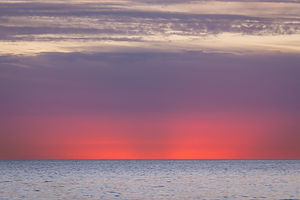 Carpinteria State Beach Double SunsetCarptineria State Beach was quite a find. I am not 100% sure, but I think it might be the only place along the California coast that you can actually camp right on the beach with an RV. The back end of our motorhome was literally hanging over the sand. It was so nice listening to the surf after spending 12 days in the desert.
Carpinteria State Beach Double SunsetCarptineria State Beach was quite a find. I am not 100% sure, but I think it might be the only place along the California coast that you can actually camp right on the beach with an RV. The back end of our motorhome was literally hanging over the sand. It was so nice listening to the surf after spending 12 days in the desert.
It wasn’t cheap though. I think we paid $80 a night for a beachfront site with full hookup. However, it was worth every penny. The other nice thing about the location was that it is only 15 miles south of Santa Barbara.
At first we thought we would head right up to Santa Barbara, but the beach was so inviting that we got out our beach chairs and spent the afternoon reading and relaxing. We also took an exploratory run into the town of Carpinteria, which was actually quite nice – the kind of place I could picture living in.
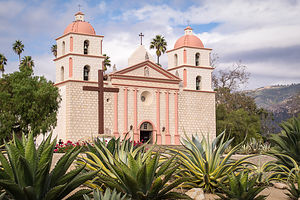 Mission Santa BarbaraDuring our run we passed a community pool that was open all year. Herb loves to swim, and when we are home, he goes 3 times a week to the local YMCA. I stopped in quickly to inquire about their hours and fees, in case Herb wanted to take a swim in the morning. We then continued back along the beach.
Mission Santa BarbaraDuring our run we passed a community pool that was open all year. Herb loves to swim, and when we are home, he goes 3 times a week to the local YMCA. I stopped in quickly to inquire about their hours and fees, in case Herb wanted to take a swim in the morning. We then continued back along the beach.
Then it was back out to the beach chairs, this time with a glass of wine, to watch the sunset. You could see the Channel Islands off the coast from here as well as about a half a dozen oil rigs. I didn’t realize before just how much oil drilling is done off the California coast. At night, they were lit up like Christmas trees along the horizon.
Originally, we thought we would only stay here one night, but it was so nice that we decided to go for a second. The next morning, Herb went off to the community pool and I went for a run into town and along the beach.
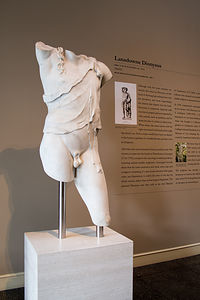 Santa Barbara Art MuseumAfter lunch, we drove up to Santa Barbara, picking just a few of its many sites to explore. Our first stop was Old Mission Santa Barbara, the 10th mission founded by the Spanish Franciscans in 1786 during their drive to convert the heathen Native Americans to Christianity and establish a presence along the California coast. When Mexico won its independence from Spain, it forced the secularization of all the missions, except for this one. As a result, it still functions as a Franciscan friary and parish church. When we were there and the hour struck, it was very obvious that the bells in the church were not automated, but manually rung by a friar – not in a bad way, but you could just tell.
Santa Barbara Art MuseumAfter lunch, we drove up to Santa Barbara, picking just a few of its many sites to explore. Our first stop was Old Mission Santa Barbara, the 10th mission founded by the Spanish Franciscans in 1786 during their drive to convert the heathen Native Americans to Christianity and establish a presence along the California coast. When Mexico won its independence from Spain, it forced the secularization of all the missions, except for this one. As a result, it still functions as a Franciscan friary and parish church. When we were there and the hour struck, it was very obvious that the bells in the church were not automated, but manually rung by a friar – not in a bad way, but you could just tell.
The mission is open to the public for both self-guided and docent-led tours for an admission fee of $7. We took the self-guided tour and wandered around the church, the old historic cemetery, and the sacred garden ourselves. There was also a very good movie explaining the Spanish mission system and this mission in particular. I recommend watching the movie first, so you have a better understanding of the rest of what you see.
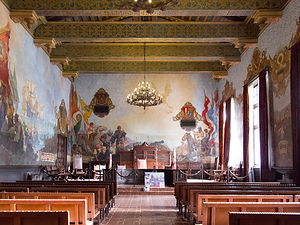 Santa Barbara Courthouse Mural RoomOur next stop was the Santa Barbara Art Museum on State Street. A docent-led tour was starting in a few minutes, so we waited and were fortunate enough to have the docent completely to ourselves – our very own private tour of the museum’s collection of Asian Art (Chinese, Japanese, Indian, and Tibetan), 19th and early 20th century French and English Art, early 20th century American Art, and Photography.
Santa Barbara Courthouse Mural RoomOur next stop was the Santa Barbara Art Museum on State Street. A docent-led tour was starting in a few minutes, so we waited and were fortunate enough to have the docent completely to ourselves – our very own private tour of the museum’s collection of Asian Art (Chinese, Japanese, Indian, and Tibetan), 19th and early 20th century French and English Art, early 20th century American Art, and Photography.
Then it was on to the Santa Barbara Courthouse, probably one of the most beautiful and highly visited courthouses in America. The original building was destroyed by the 1925 earthquake and replaced by this magnificent Spanish-Moorish Revival style building. We caught up with a guided tour in the second-floor Mural Room where the walls are covered by 6,400 square feet of paintings depicting scenes from Santa Barbara’s history – from Conquistadors to John C. Fremont. The murals, which were done by Daniel Sayre Groesbeck, were quite dramatic, not surprising considering the fact that he was a Hollywood studio artist. He worked with Cecil B. DeMille on many films, such as The Ten Commandments.
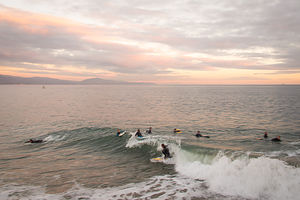 Santa Barbara Beach SurfersThe building was so impressive that it was hard to believe that it was a functioning courthouse, but our guide did take us through the main part of the building where in deed there were jury rooms, court rooms, administrative offices, legal libraries, and all the other things you would expect in a courthouse. Maybe jury duty wouldn’t be as bad if you could do it in a setting like this.
Santa Barbara Beach SurfersThe building was so impressive that it was hard to believe that it was a functioning courthouse, but our guide did take us through the main part of the building where in deed there were jury rooms, court rooms, administrative offices, legal libraries, and all the other things you would expect in a courthouse. Maybe jury duty wouldn’t be as bad if you could do it in a setting like this.
The last part of the tour was up to the top of the 85-foot clock tower where we were treated to panoramic views of the city and the surrounding coast and mountains. We also got a peek at the gears and inner workings of the clock itself, a rare Seth Thomas model 18 tower clock built and installed in 1929.
While there was so much more to see and do in Santa Barbara, we felt that we had at least gotten a little taste of its history and culture. We ended our day in Santa Barbara along the harbor, where we dined al fresco at a little take-out place called On the Alley and then watched the surfers wait for the perfect wave at the end of the pier.
Description
Carpinteria State Beach
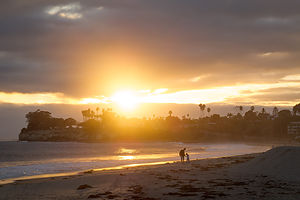 Santa Barbara Beach SunsetJust 12 miles south of Santa Barbara, Carpinteria State Beach offers a mile of beach for beach-side camping, swimming, fishing, and tidepool exploration. It is an extremely popular destination, so camping reservations should be made well in advance.
Santa Barbara Beach SunsetJust 12 miles south of Santa Barbara, Carpinteria State Beach offers a mile of beach for beach-side camping, swimming, fishing, and tidepool exploration. It is an extremely popular destination, so camping reservations should be made well in advance.
Harbor seals and sea lions can be seen December through May, along with an occasional gray whale passing through. Tidepools contain sea anemones, starfish, crabs, snails, sea urchins, and octopus. The Channel Islands and oil rigs can also be seen along the horizon.
The campground has over 200 sites with full or partial hookups, many of which are situated right on the edge of the beach. The campground is in walking distance to the lovely little town of Carpinteria.
Santa Barbara
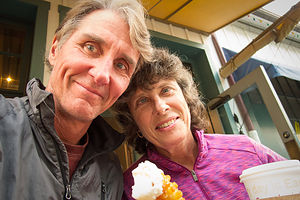 Herb and Lolo Dining at On the AlleyOften referred to as the “American Riviera” because of its Mediterranean-like climate, Santa Barbara lies sandwiched between the Pacific Ocean and the Santa Ynez Mountains. It has the longest section of south-facing coastline on the West Coast, boasting views of both sunrise and sunset. The city was founded by Spanish missionaries in 1786, and its Mission revival style of architecture, with is white stucco buildings with red-tile roofs, is a testament to its Spanish past.
Herb and Lolo Dining at On the AlleyOften referred to as the “American Riviera” because of its Mediterranean-like climate, Santa Barbara lies sandwiched between the Pacific Ocean and the Santa Ynez Mountains. It has the longest section of south-facing coastline on the West Coast, boasting views of both sunrise and sunset. The city was founded by Spanish missionaries in 1786, and its Mission revival style of architecture, with is white stucco buildings with red-tile roofs, is a testament to its Spanish past.
Our stop in Santa Barbara was brief, so this in no way is an attempt to give a thorough description of what to see there. However, the following three sites are what we chose to do during our all too short one day visit:
Mission Santa Barbara lies atop a hill overlooking the town. It was the tenth of the California missions to be founded by the Spanish Franciscans, and was established on the feast of Saint Barbara on December 4, 1786. Being the only mission escape Mexico’s policy of forced secularization, the mission still functions as a Franciscan friary and parish church. The mission offers both self- and docent-guided tours of the church, historic cemetery, and sacred garden. Admission is $7
The Santa Barbara Museum of Art on State Street has an impressive collection, focused on Asian Art (Chinese, Japanese, Indian, and Tibetan), 19th and early 20th century French and English Art, early 20th century American Art, International Modernism, Photography, and Contemporary Art. Admission is $10.
The Santa Barbara Courthouse is probably one of the most visited courthouses in America. This magnificent Spanish-Moorish Revival style building was completed in 1929 as part of a rebuilding process after an earthquake destroyed the smaller Greek-Revival one in 1925. It is considered by many to be the most beautiful government building in America. Visitors can ride an elevator to the top of the 85-foot clock tower for magnificent, panoramic views of the city, coast, and mountains. The other main attraction is the second-floor Mural Room, with 6,400 square feet of paintings by Daniel Sayre Groesbeck, depicting scenes from Santa Barbara’s history. Admission is free..
- ‹ previous
- 8 of 13
- next ›
Carpinteria State Beach / Santa Barbara location map in "high definition"
Javascript is required to view this map.
